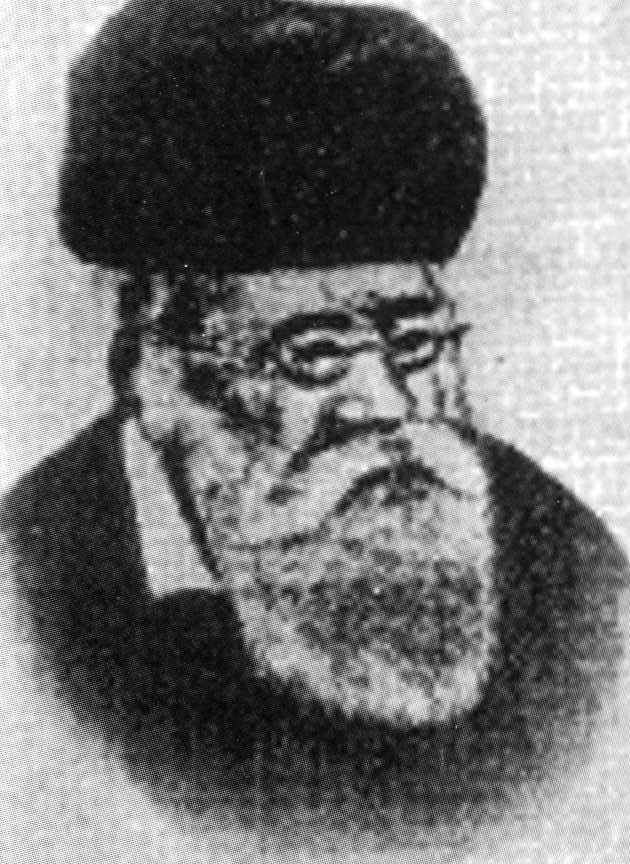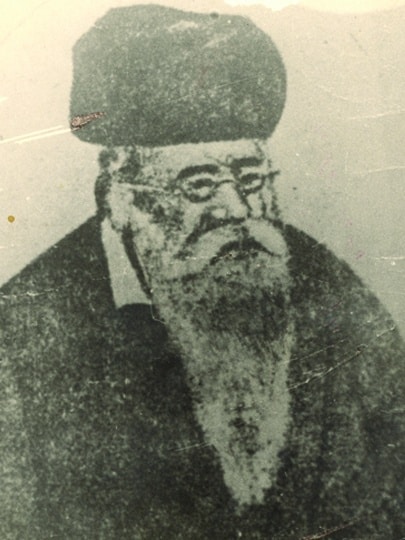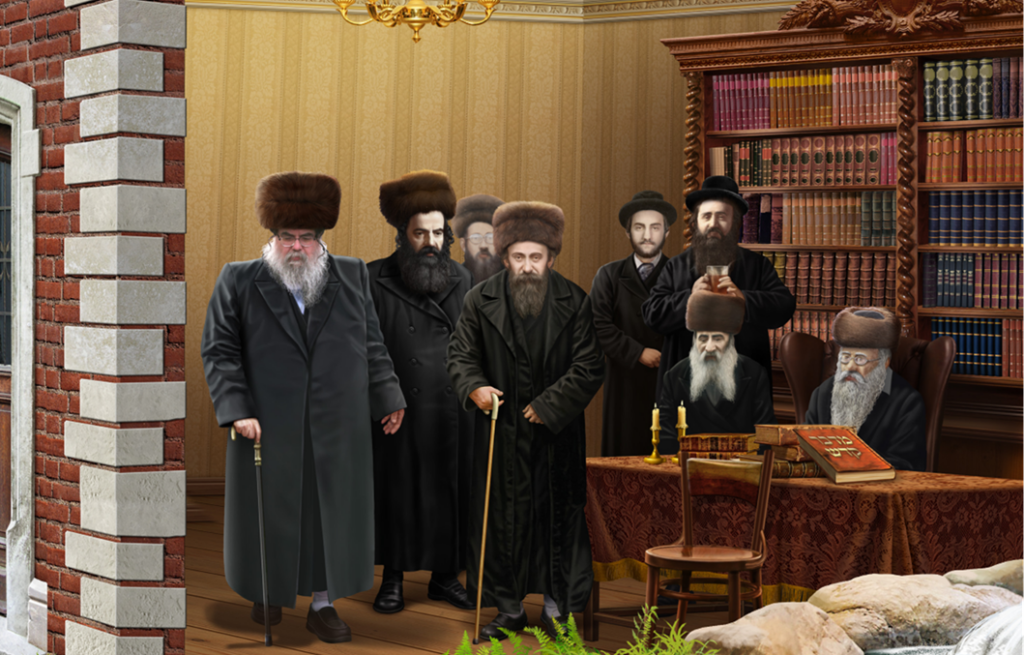

ABOUT – THE HISTORY OF BELZ
The Mittler Rav
The Second Belzer Rebbe
The Sar Shalom was succeeded by his youngest son Rabbi Yehoshuah, whose position was ratified posthumously by his saintly father several days after he passed away. He appeared before his eldest son Rabbi Elazer while he was praying in the famous synagogue and confirmed that it was his wish that he should be succeeded by none other than his youngest son!
Initially, Belz under the leadership of the Mittler Belzer Rov, as Rabbi Yehoshuah is commonly referred to, went through a difficult transition. Firstly, at approximately 30 years of age, by the prevailing standards of the time, the Rebbe was considered a young man. Also the concept of a hereditary rabbinical position was relatively revolutionary. Most Rabbis and religious leaders at that time were succeeded by a chosen disciple, not by their descendants. In a case, however, where a son was appointed to succeed his father, the natural presumption would be for the eldest son to be appointed, not the youngest, as was the case in Belz.

Then there were doubts of a more personal nature. Whereas the previous Rebbe had travel extensively in his youth to meet the great Chassidic leaders of his time and had drunk deeply from their wellsprings of wisdom, his successor had not done so at all.
His father, Reb Shalom, was introduced to the teachings of Chassidus in Sokal shortly after his marriage by Rabbi Shlome Lutzker the Maggid of Sokal, and he was also a disciple of the Holy ‘Seer’ of Lublin. He could also count amongst his teachers the Maggid of Koznitz who taught him how to ‘read’ a K’vittle and bequeathed him the famous power to heal by touching an afflicted limb with his holy hands, the Seraph Reb Urele of Strelisk who revealed to him the Torah scroll in the form of black fire written on white fire as it was showed by G-d to Moses in heaven, and the holy Reb Yehoshuah Heshil of Apte who prophesied that in years to come their descendents would join in marriage. Indeed years later, Reb Yehoshuah married the Apte Rov‘s great-granddaughter.
A New Era
His father was his only Rebbe, and his father had passed on to him all the priceless treasures that he had amassed in his vaults, therefore he had no need to travel in pursuit of wisdom from any other source!
Reb Yehoshuah, on the other hand, never traveled to any of the famous houses of study and did not serve any of the great masters of his time. He used to say that his father was his only Rebbe, and his father had passed on to him all the priceless treasures that he had amassed in his vaults, therefore he had no need to travel in pursuit of wisdom from any other source!
With the benefit of hindsight we can look back and see that the Chassidic movement had just transcended into a new era. Whereas the holy Sar Shalom belonged to the first era, to the era of the Baal Shem Tov, the founder of the Chassidic movement and his disciples, his son Reb Yehoshua was in the vanguard of the second era. Indeed he was instrumental in guiding and forming the Chassidic movement as it developed into the form that we are familiar with today.
In the first era most of the followers of a Chassidic Rebbe were disciples who were attracted to their Rebbe so as to learn his method of Torah study and to absorb his founts of knowledge and wisdom, and most of these disciples went on in due course to become a Rebbe in their own rights. The Rebbes in the second era started to attract followers of a more simple nature, many of whom never went on to become a Rebbe, and were content to remain a Chossid throughout their entire lives. This is perhaps the reason why in the second era each Chassidic movement evolved into a hereditary dynasty, whereas in the first era the mantle of leadership passed on to the most appropriate disciple.
But many of the changes that came about were of a much more profound nature. Winds of change were blowing and the religious and social scenery was changing dramatically and it was the stewardship of the Mittler Belzer Rebbe, together with several other great Rabbis of the time that helped the religious communities to adapt to the new times and to rise and confront the new challenges. Some of Reb Yehoshuah’s crowning achievements were considered extremely revolutionary at that time, while today they are part of the very fabric of our society and we could not imagine life without them!
Combating Opposition
Throughout Europe, and especially within the boundaries of the Austro-Hungarian Empire, Jews were afforded social rights and freedom as never before. This encouraged many Jews to embrace a religious liberalism and a secular lifestyle in which traditional Jewish customs and values took little or no place. A greater problem was the liberal freethinkers, the so called Maskilym or enlightened ones. The former were motivated purely by their personal considerations and selfish desires, and their regard for their fellow Jews who chose to adhere to their former way of life ranged from reluctant respect tinged with slightly guilty feelings to indifference or even pity. The latter, however, actively pursued their freestyle approach to Judaism as an ideological achievement, and regarded traditional values as a threat that needed to be eradicated at any cost. To this end they petitioned the government to introduce laws outlawing what they termed old fashioned ‘outdated’ practices. They tried to obtain legislation requiring prospective Rabbis to have secular qualifications, rather than traditional rabbinical ordination, or to impose bans on traditional Jewish slaughter. They established schools – the so called Rabbiner Seminar, to teach their enlightened version of Judaism and to train Rabbis to practise their liberal views.
In order to coordinate their efforts they formed organizations with misleading names like Shomer Yisroel – The Guardians of Israel, and presented themselves as the representatives of the Jewish people. Under these flags they even put forward candidates for parliamentary elections. They felt confident and secure in the presumption that the religious groups, who they regarded as fanatical and hopelessly outdated, would never be able to mount an effective response.
Machzeikei Hadas is Established
They did not take into account the Belzer Rebbe, who realized the potential danger for traditional Judaism if they were allowed to represent the Jewish people unchecked. He joined forces with Rabbi Shimon Sofer the Rabbi of Krakow and several other great religious leaders with similar foresight, and together they established an organization called Machzikei Hadas – literally translated the upholders or the guardians of the religion. The organisation was ratified in the year 5638 (1878) by the representatives of over 200 orthodox Jewish communities who had gathered for a mega conference in Lemberg, the then capital of Galicia.
In the course of the conference a constitution was drawn up and Rabbi Shimon Sofer was elected as president of the organization. Over the next year or two local branches were established in towns and villages throughout Galicia.
In the year 5639 (1879), MachzikeI Hadas put forward their own candidates for the Austro – Hungarian parliamentary elections. What the religious Jews lacked in experience and knowledge of the electoral by-laws they made with their dedication and coordinated efforts, and their campaign was crowned with success; Rabbi Shimon Sofer was elected a member of parliament. He was thus the first religious Jew to serve as a Member of Parliament as a representative of the religious Jewish population and his election marked their virgin venture into the world of politics.
At around the same period the Haskala movement introduced a new tactic in their campaign to gain the upper hand and exert their influence over traditional Jewry. Traditionally, Haskala – ‘enlightenment’, was directed towards the intellectual members of society, the Talmudic students and young Rabbis, whereas the simple Jews, the peasants and tradesmen were largely ignored and hence unaffected by the Maskilim. They were by and large happy to continue in the ways of their forefathers and to be guided by their Rabbis and religious leaders and did not get involved in theological debates, so they could not be drawn to change alliances. Then the Haskala movement started to publish newspapers. Written in German, Yiddish and even Hebrew and bearing traditional Jewish names like Der Israelit or Kol Yisroel (The Voice of Israel), they managed to penetrate the soft underbelly of the traditional communities.
Initially the traditionalists tried to stop them cold by banning the introduction of the newspapers to Jewish homes, but they were fighting a losing battle. Once again it was the Mittler Rov who realized the true threat these newspapers posed, and in characteristic manner he countered the threat by instigating the publication of a religious newspaper under the auspices of the new religious party, the MachzikeI Hadas. Whereas the founding of the first religious Jewish political party was regarded by many as controversial, nevertheless it was endorsed and ratified by the major communities and religious leaders. The publication of the Machzikei Hadas and the Kol Machzikei Hadas, as the first ever religious newspapers were called, met however with fierce opposition.
Reb Yehoshuah was relentless. He proclaimed again and again that it was essential to have a self controlled media with which to express the views and opinions of the orthodox establishment and to counter the threat the newspapers published by the Haskala movement posed.
But Reb Yehoshuah was relentless. He proclaimed again and again that it was essential to have a self controlled media with which to express the views and opinions of the orthodox establishment and to counter the threat the newspapers published by the Haskala movement posed. Eventually, he convinced most Rabbis and religious leaders and obtained their endorsement and support. In due course it has become an integral part of our life, to the extent that it would be difficult to imagine the world today without its variety of religious Jewish newspapers and periodicals.
Penchant for Handwritten Manuscripts
Rabbi Yehoshuah had an interesting and expensive hobby. He loved to purchase handwritten manuscripts of kabbalistic writing written by famous Jewish sages and over the years he collected many important works. However, he was not interested in the monetary value of the works, nor, unlike many other collectors of manuscripts, was he interested in keeping them secreted away. On the contrary, his main motivation was to learn their intrinsic secrets, and to share those secrets with the rest of the world. He spared no price and was prepared to do anything necessary to achieve this lofty goal for the benefit of Torah students. Sometimes he would invite a descendant of the author of one of his manuscripts to print their forefather’s work, and in one occasion he offered a descendent to reside in Belz for as long as was necessary to copy a manuscript and edit it while supporting his every need. He even presented a certain publisher with an entire treasure trove of previously unpublished manuscripts written by the famous medieval Italian KabBalist the Rema Mi-Pano. This is one of the Mittler Rav’s lesser-known contributions to the Torah world because he forbade the recipients of his generosity to publish the good deeds. It is only from the foreword of those manuscripts that were published posthumously that we know about his selfless generosity.

Incidentally, the recipient of the manuscripts of the Rema Mi-Pano never managed to publish the entire collection he received, but luckily he published a list of the manuscripts included in the priceless gift he received from the Belzer Rebbe. In recent years the entire collection was discovered in one of the European libraries and work is being done to publish them so that the Rebbe’s selfless desire is finally being fulfilled.
A Dynamic Leadership Comes to an End
Reb Yehoshuah the Mittler Rav reigned in Belz for close to 40 years. While his early years were beset with many reservations, over the years he was recognized and accepted as one of the generations most dynamitic and forceful leaders. His name has gone down in history as one of the greatest guardians of traditional Jewish values and at the same time one who successfully navigated the transition into the realities of modern times. But he was also a world leader in compassion for his fellow Jews.
Thousands came to him from near and far for his advice and blessings and he would spend hours on end praying for them and trying to evoke Divine intervention to solve their many problems.
Thousands came to him from near and far for his advice and blessings and he would spend hours on end praying for them and trying to evoke Divine intervention to solve their many problems.
In the year 5654 (1894) Reb Yehoshuah travelled to Vienna to seek specialist medical treatment and to undergo an operation. Apparently he felt that his ailments were hindering him during his prayers and preventing him from attending to the needs of his many followers and he risked his life on their behalf. The operation was successful but he passed away on the train while he was making his way back to Belz. His funeral was attended by thousands of mourners and he was succeeded by his third son Rabbi Yissochor Dov.
Stories of the Mittler Rav
Building on its illustrious Rabbinical dynasty, Belz remains an epicenter for Yiddishkeit (Judaism) until the coming of Moshiach.


INSPIRE YOUR INBOX.
Enjoy a weekly dose of Chassidic insights, highlights and happenings.
